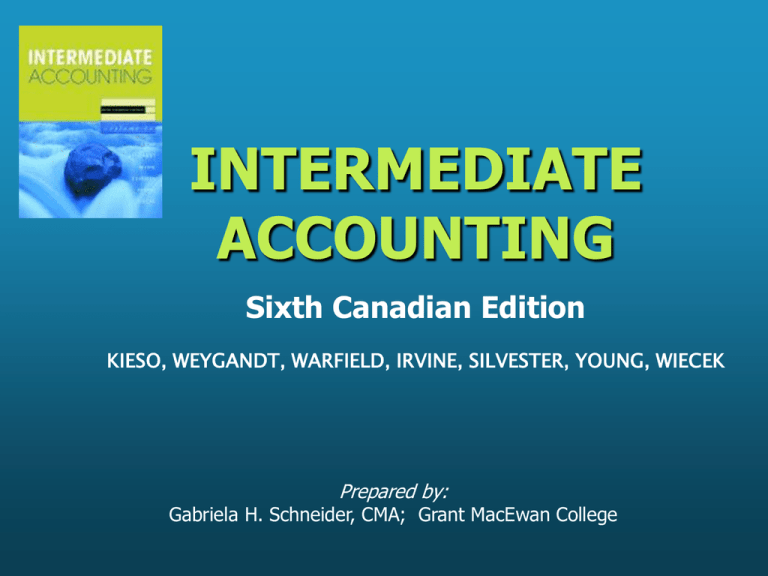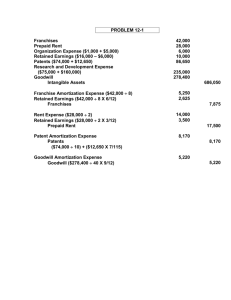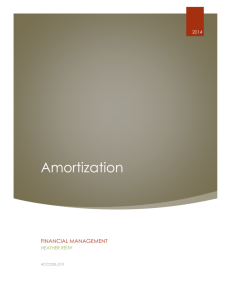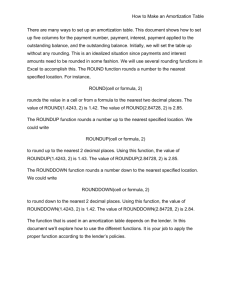
INTERMEDIATE
ACCOUNTING
Sixth Canadian Edition
KIESO, WEYGANDT, WARFIELD, IRVINE, SILVESTER, YOUNG, WIECEK
Prepared by:
Gabriela H. Schneider, CMA; Grant MacEwan College
CHAPTER
12
Amortization, Impairments,
and Depletion
Learning Objectives
1. Explain the concept of amortization.
2. Identify and describe the factors that must
be considered when determining
amortization charges.
3. Determine amortization charges using the
activity, straight-line, and decreasing charge
methods and compare the methods.
4. Explain special amortization methods.
Learning Objectives
5. Identify and understand reasons why
amortization methods are selected.
6. Explain the accounting issues related to
asset impairment.
7. Explain the accounting procedures for
depletion of natural resources.
8. Explain how tangible capital assets, including
natural resources are reported and analysed.
Amortization, Impairments, and
Depletion
Amortization
Impairments
Depletion
Factors involved
Recognizing
impairments
Establishing a
base
Measuring
impairments
Depletion of
resource cost
Restoration of
loss
Oil and gas
accounting
Assets to be
disposed of
Special problems
Methods of cost
allocation
Special methods
Selecting a
method
Special issues
Presentation
and Analysis
Presentation
Analysis
Amortization - Concept
• Depreciation (Amortization) is a means of cost
allocation
• It is not a method of valuation
• Depreciation involves:
• Allocating the cost of capital assets to expense
(matching principle) in a systematic and rational
manner to periods expected to benefit from use of
assets
• The terms amortization and depreciation are
used interchangeably
Factors in the Amortization
Process
Questions to be answered:
1. What amount of the asset’s cost is to be
amortized?
2. What is the asset’s useful life?
3. What pattern and method of cost
apportionment is best for this asset?
•
Which amortization method best matches the
way this asset is used/consumed?
Amount to Be Amortized
• Depreciable base is the amount subject
to depreciation
• It is determined as:
• original cost of the asset less
• estimated salvage or disposal value
Useful Life of an Asset
• An asset’s useful life and physical life are not the same
(expressed in time or units)
• Useful life is sometimes referred to as the economic life
• The period of time over which the asset will produce
revenue for the company
• Assets are retired (from productive life) due to:
• physical factors (such as casualty)
• economic factors (such as obsolescence)
• Economic factors in turn include:
• inadequacy (asset can not meet current demand)
• supercession (by a better asset)
• obsolescence (other factors)
Amortization Methods: Overview
Amortization
Methods
Financial Accounting
Amortization Methods
Activity
method
Straight-line Accelerated
method
methods
1. Declining-balance
2. Sum-of-the-years’-digits
Tax
Amortization
Increasing
Charge
Methods
Special
methods
1. Group and Composite
2. Hybrid methods
Amortization Methods: Example
Crane Ltd. buys a crane on January 1, 2000.
Information relating to the crane is as follows:
•
•
•
•
Cost: $500,000
Estimated useful life, 5 years (or 30,000 hours)
Salvage value end of five years or use, $50,000
Actual hours used during the year:
•
4,000 hours – 2000 and assume 4,700 in 2001
Based on this information, calculate the amortization
for the year 2000 using: units of use, straight-line
and the accelerated methods
Activity Method (unit = hour)
This same
1. Depreciable base = $500,000 - $50,000 = $450,000
rate is used
year/ 30,000 = $15.00
2. Amortization per hour = each
$450,000
3. Amortization (2000) = $15.00 X 4,000 hours = $60,000
Amortization (2001) = $15.00 X 4,700 hours = $70,500
4. Amortization Schedule:
Year Book Amortization
Value
Expense
1
$500,000 $60,000
2
$440,000 $70,500
Accumulated
Amortization
$ 60,000
$130,500
Book value
End of year
$440,000
$369,500
Straight-Line Method
1. Depreciable base = $500,000 - $50,000 = $450,000
Note that the
2. Annual Amortization = $450,000 / 5 years = $90,000
depreciation
expense is the
3. Amortization Schedule:
each year!
Year Book Amortizationsame
Accumulated
Book value
1
2
Value
Expense
$500,000 $90,000
$410,000 $90,000
Amortization
$ 90,000
$180,000
End of year
$410,000
$320,000
Declining
Rate= (100%
BalanceUseful
Method
Life) X 2
1. Rate of Amortization = 2 X (1/5) = 40%
2. Amortization (2000) = $500,000 X 0.40 = $ 200,000
Amortization (2001) = ($500,000 - $200,000) X 0.40
= $120,000
3. Amortization Schedule:
Year Book Amortization Accumulated
Last year is Book value
Value
Expense
Amortization
rounded. BookEnd of year
1 $500,000 $200,000
$200,000
value cannot be $300,000
2 $300,000 $120,000
$320,000
less than salvage$180,000
3 $180,000 $ 72,000
$392,000
$108,000
value
4 $108,000 $ 43,200
$435,200
$ 64,800
5 $ 64,800 $ 14,800
$450,000
$ 50,000
Sum-of-the-Years’-Digits Method
1. Depreciable base = $500,000 less $50,000 = $450,000
2. SYD fraction = (1+2+3+4+5) = 15
3. Amortization (2000) = $500,000 X (5/15) = $166,667
Amortization (2001) = $500,000 X (4/15) = $133,333
Do not
3. Amortization Schedule:
depreciate
Year Book Amortization
Accumulated
Book value
Decreasing
Fractions
belowAmortization
salvage
Value
Expense
End of year
value $166,667
1 $500,000 $166,667
$333,333
2 $333,333 $133,333
$300,000
$200,000
3 $200,000 $100,000
$400,000
$100,000
4 $100,000 $ 50,000
$450,000
$ 50,000
5 $ 50,000 $ -0$450,000
$ 50,000
Group and Composite
Amortization Methods
• The group method is applied to a collection of
assets similar in nature
• The composite method is applied to a
collection of assets dissimilar in nature
• The composite amortization rate is
determined as follows:
total of annual amortization for all assets
total cost of all assets
Composite Amortization Method:
Example
Given the following information relating to fixed
assets, A and B:
Asset
A
B
Cost
$20,000
$36,000
$56,000
Annual amortization
$ 4,000
$10,000
$14,000
Composite amortization rate is: $14,000 = 25%
$56,000
Group and Composite
Amortization Methods
• When an asset is sold, or otherwise
disposed of, under group/composite
amortization:
– no gain or loss on disposal is recorded
– the difference between cost and sale
proceeds is debited to Accumulated
Amortization
Partial Year Amortization
• When an asset is bought sometime
during the year, a partial amortization
charge is required
• The procedure is:
• determine amortization for a full year, and
• allocate the amount between the two
periods affected (see example ==> )
Selecting an Amortization
Method
•
Three main factors or motivations for
method of selection:
1. Matching
2. Simplicity
3. Perceived economic consequences
•
Where possible, matching is the best
motivation for method selection
Amortization and Partial Periods
Units of Production/Use Method:
• No special calculations required
• Calculate the usage rate and apply to actual for the
period
• Same rate used in subsequent years
Straight-Line Method
• Calculate the amortization for the portion of the year
• Generally use the nearest full month
Declining Balance
• More complex calculations involved
Partial Year Amortization: Example
• Amber Ltd. buys a truck on July 1, 2000.
Information relating to the truck is as follows:
• Cost: $10,000
• Estimated service life: 5 years
• Salvage value end of five years: none.
• Determine amortization expense under the
declining balance method.
•Determine
full year amortization as follows:
First full year (2000) = $10,000 X 40% = $4,000
Second full year
= $6,000 X 40% = $2,400
Third full year
= $3,600 X 40% = $1,440
Partial Year Amortization: Example
Double declining: date of purchase, July 1, 2000
Allocate first full year’s
amortization of $4,000
between 2000 and 2001
$2,000
2000
Allocate second full year’s
amortization of $2,400
between 2001 and 2002
$2,000 $1,200
$1,200
2001
2002
Revision of Amortization
Estimates
•
•
•
•
Determination of amortization involves
initial estimates (life, salvage value)
When these estimates are revised,
amortization is recalculated
These revised amortization expenses
apply prospectively to the remaining life
of asset
The changes do not affect prior periods
Revision of Amortization Estimates:
Example
• ABC Ltd. buys a depreciable asset on January
1, 2000 for $95,000.
• Estimated life was 20 years.
• Estimated salvage value was $5,000.
• On January 1, 2006, estimates were revised
as follows:
• Salvage value, $2,000
• Estimated life : 24 years (years 2000 through 2023)
• Determine amortization for 2006 based on
the straight-line method of amortization
Revision of Amortization Estimates:
Example
• Accumulated Amortization to date of
revision of estimates:
• ($95,000 - $5,000) / 20 years = $4,500 per year
• $4,500 X 6 years = $27,000 Accumulated
Amortization
• Book Value: $95,000 - $27,000 = $68,000
• Amount to be amortized (years 2006
through 2023 = 18 years)
• ($68,000 - $2,000) / 18 years = $3,667 (rounded)
annual amortization
Impairments
• An impairment occurs when:
• the carrying amount of an asset is not
recoverable, and
• a write off of the impaired amount is
needed
• To determine the amount of
impairment, a recoverability test is used
(see next slide)
Impairments: The Recoverability Test
Impairment?
Sum of expected
future net cash flows
from use and disposal
of asset is less than
the carrying amount
Impairment has occurred
Sum of expected
future net cash flows
from use and disposal
of asset is
equal to or more than
the carrying amount
No impairment
Impairments: The Recoverability Test
Impairment has occurred
Determine
impairment loss
Yes
Does an active market
exist for the asset?
No
Use company’s market
rate of interest
Loss =
Carrying amount
less
Fair value of asset
Loss =
Carrying amount
less
present value of
expected net cash
flows
Impairment: Accounting
Impairment has occurred
Assets are held
for use
1. Loss = carrying value
less fair value
2. Amortize new cost basis
3. Restoration of impairment
loss is not permitted
Assets are held
for sale
1. Loss = carrying value
less fair value less
cost of disposal
2. No amortization is taken
3. Restoration of impairment
loss is permitted
Depletion: Terminology
• Depletion refers to the cost basis write
off of natural resources
• Natural resources are characterized by:
• complete removal of the asset
• replacement of the asset only by an act of
nature
Determining the Depletion Base: Factors
Types of Costs
• Acquisition cost
•
• Exploration costs
•
• Development costs
•
• Development costs
•
(Tangible costs): not
part of depletion base
(Intangible costs)
• Restoration costs
•
What they Are
Price paid to search for
and find deposit of the
natural resource
Costs incurred to find
the natural resource
Costs of heavy
equipment for
extracting and shipping
natural resources
Drilling costs, tunnels,
and shafts
To restore after
extraction
Accounting for Exploration
Costs
• Two competing approaches are employed
in practice to account for exploration costs
– Successful efforts approach
• only exploration costs of successful projects are
capitalized
– Full-cost approach
• all costs are capitalized
• Both approaches are currently practised in
Canada
Depletion of Resource Cost
• Depletion calculated using an activity
approach (units of production)
• Depletion charge initially debited to Inventory
• Credited when the resource is sold
– Follows matching principle
• Where useful life clearly linked to the
resource, tangible assets are amortized using
units of production method
Special Problems
• Difficulty of Estimating Recoverable Reserves
• Revise depletion rate on a prospective basis
• Future Removal and Site Restoration Costs
• Costs should be recognized if they can be
reasonably measured, otherwise a contingent
liability should be disclosed
• Accounting for Liquidating Dividends
• Reduce the respective Share Capital account for
the related portion
COPYRIGHT
Copyright © 2002 John Wiley & Sons Canada, Ltd.
All rights reserved. Reproduction or translation of
this work beyond that permitted by CANCOPY
(Canadian Reprography Collective) is unlawful.
Request for further information should be
addressed to the Permissions Department, John
Wiley & Sons Canada, Ltd. The purchaser may
make back-up copies for his / her own use only and
not for distribution or resale. The author and the
publisher assume no responsibility for errors,
omissions, or damages, caused by the use of these
programs or from the use of the information
contained herein.





